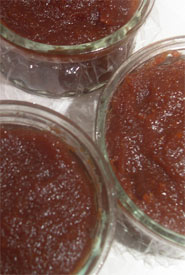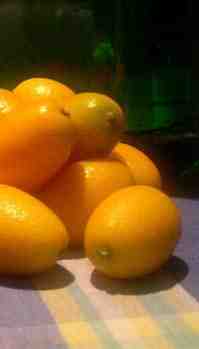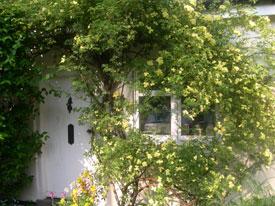Easy quince cheese recipe (membrillo)
Posted by Fiona Nevile in Fruit, Jam Jelly and Preserves, Vegetarian | 156 comments I’m back at the helm and it’s marvellous to be feeling well and chirpy and slimmer. Forget Champneys. A week in bed with a bug does wonders for the figure.
I’m back at the helm and it’s marvellous to be feeling well and chirpy and slimmer. Forget Champneys. A week in bed with a bug does wonders for the figure.
Danny put on his sensible parent hat this morning. He instructed me not to go to work, reasoning that more recuperation was required. He was right. I did feel weak.
This afternoon, he relented slightly.
“Why not go out foraging for an hour. You could do with some fresh air.”
He passed me the foraging stick, tossed me his car keys and disappeared upstairs.
I found some plump sloes and with the help of the walking stick accessed branches that only a seven foot giant could reach. The crab apple tree had a small final harvest. Being north facing its fruit had not spoiled. I tootled home and simmered the crab apples with chillies to make a hot jelly (recipe later this week if it turns out well).
My main aim today was to make some quince cheese. The quinces had been cooked and strained for jelly the week before last. The juice and flesh keep well in the fridge for up to two weeks. Today was the last day.
When I discovered membrillo at the Spanish Deli in Portobello Road I was delighted. I love the combination of membrillo and Manchego. Danny wasn’t impressed. His face crumpled when he tasted it.
“It’s so sweet. How can you like it?”
I was pretty sure that membrillo needn’t be so sweet. I looked at various recipes on the internet. The amount of sugar varied enormously. In the end I decided to plump for an equal volume of quince pulp to sugar. This has produced a membrillo that is sweet but tastes of quince. I reckon that one could get away with even less sugar in fact when I looked in my copy of Oded Schwartz, his recipe uses slightly less – 50g less. Adding the lemon juice made a difference too.
They key to this recipe is time. I simmered the quinces for at least three hours until they became a deep pink colour. The final stage is a long process too. The quince pulp and sugar was simmered gently (lowest setting) for a good 2-3 hours to intensify the colour and thicken the pulp to the right consistency. There is no need to bring the mixture to a rolling boil. This is a recipe that is spread over two evenings. One evening simmer the quinces and strain overnight. The next evening make the membrillo.
Danny tasted it gave the recipe the thumbs up, especially when he realised that the by product is the juice for quince jelly.
Easy quince cheese recipe (membrillo)
Ingredients:
For the quince pulp:
- 1 kilo of quinces
- Zest of half a lemon
- Water to cover
For the quince cheese:
- Quince pulp
- Juice of half a lemon
- Granulated (not castor) white sugar (equal volume to the pulp)
Method:
- Rub the down off the quinces and wash them. There is no need to peel or core the quinces.
- Chop the quinces carefully, as they are hard it is easy for the knife to slip. I chopped them into quarters and sliced them into 1cm slices.
- Place the quince slices in a large saucepan or casserole dish and add water so that they are just floating. Add the zest of half a lemon.
- Bring slowly to the boil and then turn the hob down to it’s lowest setting so that the quinces gently simmer (lid on). Simmer the fruit until very soft and the fruit has turned a deep pink colour. This took me about 3 hours. Check the quinces every now and then and top up the water if necessary.
- Strain the juice from the fruit overnight using a jelly bag or muslin square. Retain the juice to make quince jelly.
- I was loathe to spend hours pressing the quinces through a sieve so I put them through the Magimix
(medium grater blade) and then I sieved them.
- Measure the pulp using a measuring jug put the pulp into a large heavy bottomed saucepan or casserole dish and add an equal volume of white granulated sugar. Add the juice of half a lemon.
- Bring the pulp and sugar gradually to simmering point, stirring to dissolve the sugar and let it simmer, lowest setting for 2-3 hours, stirring every now and then to stop it sticking and burning. It will resemble gloopy mud. Gradually the colour will darken. Eventually the fruit will become very thick (I could stand my spoon up in mine).
- Spoon into well oiled sterilised straight sided jars and seal with cellophane lids. This will keep for months. Cut slices to eat with cheese or cold meat. Refrigerate after opening.
Leave a reply







hi all. there’s a greengrocers on rectory grove, leigh on sea, essex with fresh quinces for sale – £1 per lb. i asked where they were from and it transpires they come from a garden about 100 yards away – beat that for food miles! i made a batch of membrillo and am very happy with the results (i “greased” my container with glycerin which worked just fine).
Hi Seahorse,
It is good news that you have membrillo in your house and I am so pleased that the jelly worked for you.
You should have got more jelly from 6 quinces (depending on the size). Did you keep the lid on when simmering? And let the quinces just float in the water. Quinces are bursting with pectin and flavour that you can thin an over thick juice and it will still set. However, it is easy to over thin and get an oversweet jelly.
In the end you got good jelly and membrillo and that is the main thing.
Hi Ellie,
This is great information about the quince. Thank you so much for dropping by and leaving a comment. Really useful stuff.
I thought this was rather interesting…
The modern name for quince originated in the 14th century as a plural of quoyn, via Old French cooin from Latin cotoneum malum/cydonium malum, ultimately from Greek kydonion malon “Kydonian apple” (in the figurative sense, similar to pomodoro – Italian word for tomato literally meaning “apple of gold”, pomme de terre – the French word for potato, literally meaning “apple of the ground”, and the classical “golden apple”).
The quince tree is native to Iran, Georgia, Armenia, Turkey, Albania, Macedonia, Greece, and Bulgaria, but the Greeks grafted from a superior strain from ancient Kydonia, now Khania, a port in Crete, whence both the common and better-preserved genus name. The Lydian name for the fruit was kodu.
Cultivation of quince may have preceded apple culture, and many references translated to “apple”, such as the fruit in Song of Solomon, may have been to a quince. Among the ancient Greeks, the quince was a ritual offering at weddings, for it had come from the Levant with Aphrodite and remained sacred to her. Plutarch reports that a Greek bride would nibble a quince to perfume her kiss before entering the bridal chamber, “in order that the first greeting may not be disagreeable nor unpleasant” (Roman Questions 3.65). It was a quince that Paris awarded Aphrodite. It was for a golden quince that Atalanta paused in her race. The Romans also used quinces; the Roman cookbook of Apicius gives recipes for stewing quince with honey, and even combining them, unexpectedly for us, with leeks. Pliny the Elder mentioned the one variety, Mulvian quince, that could be eaten raw. Columella mentioned three, one of which, the “golden apple” that may have been the paradisal fruit in the Garden of the Hesperides, has donated its name in Italian to the tomato, pomodoro. I’m wondering whether the apple in the bible was in fact a quince.
The term “marmalade”, originally meaning a quince jam, derives from the Portuguese word for this fruit marmelo.
The quince, used as a rootstock for grafted plants, has the property of dwarfing the growth of pears, of forcing them to produce more precociously, and relatively more fruit-bearing branches, instead of vegetative growth, and of accelerating the maturity of the fruit.
In parts of Afghanistan, the quince seeds are collected and boiled and then ingested to combat pneumonia. It is also a known remedy for lung disease.
I made membrillo! It’s deep red and delicious. The quince jelly seemed to work too, though just three jars from six quinces. When you said to just cover with water, that’s what I did as I didn’t want to overdo it on the water after the last liquid to sugar ratio upset 😉 This time, a great taste, it set and is lovely and pink. My second foray into preserve making and a much better result. And yes, I think the scent coming from cooking quinces is really quite lovely. I’m going to make some more 🙂
Hi Mildred,
Great that you finally managed to find quinces. They have a wonderful scent when they are cooking and quince jelly is the best.
Hi, Waitrose got a stock of quinces in! I bought all 14 . . . yesterday I cooked 6 and made jelly today, creating 7 small (8oz) jars. I have saved the pulp and will mix it with the pulp from 6 more, simmering today, to make the cheese tomorrow.
I am going to try the recipe for ‘braising’ the other 2 for our pudding tonight!
Can there be any greater joys than the wonderful scent of simmering quinces, and the resulting beautiful jelly?
Hi Mildred,
I checked on eBay – Yes they are expensive but I bet they are selling them.
I think the problem with the availability of UK quinces is the picking cost. Also quince trees tend not to be grown on a grand scale.
Also loads of people just don’t know what to do with quinces. They are no longer part of our culture as they are on the continent.
Hello! Type ‘quince’ into Ebay (UK), someone is selling them, but WHAT a price!
The Waitrose near us are still awaiting their delivery, they keep assuring me they WILL be in any day.
I feel sure that the quince will soon be discovered by TV chefs and will become a ‘trendy food’, and will then be more easily available.
Your Membrillo looks and sounds great Fi!
Hi Jude,
You can use the quinces now or later.
I used olive oil, spread with a piece of kitchen roll. Groundnut oil is probably best as it is almost flavourless.
Glad that you are enjoying the site.
Thanks Fiona, I am new to all this business having just moved from a tiny townhouse with no garden to a big semi with a dozen fruit trees and a vegetable patch bigger than my old house!
I will give the quinces ago – should I do this now or can I leave them on the bush a bit longer?
Also, sorry about the novice question but is there a particlar way to oil the jars for the membrillo? Or any particular oil I should use?
Thanks for the lovely site, I’ll be here a lot from now on!
Jude